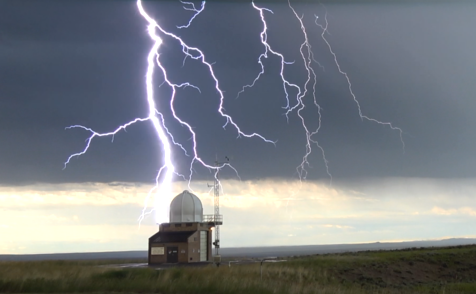

Lightning at NWS Riverton office in July 2018
- About 23 million cloud-to-ground lightning strikes occur each year in the U.S., with approximately 290,000 of them occurring in Wyoming each year.
- Over a 30 year period (1984-2014), the U.S. averaged 51 lightning fatalities per year.
- Only about 10% of people struck by lightning are actually killed. The other 90% must cope with varying degrees of discomfort and disability, sometimes for the rest of their lives.
- Lightning is responsible for more deaths and injuries across Wyoming each year than from any other thunderstorm phenomena. From 1996 to 2018, lightning has been attributed to 8 fatalities and 71 injuries across Wyoming.
- Wyoming was 1st in number of lightning deaths & injuries per capita (1959 to 2016).
Safety Information
Plan: Plan outdoor activities to avoid thunderstorms. Listen to NOAA Weather Radio All-Hazards for the latest weather forecast before heading out.
If Thunder Roars Go Indoors!: If you can hear thunder, go inside. You can audibly hear thunder out to 10 miles in any direction of your location. If you hear thunder, you are in the danger zone!
Safe Places: Fully enclosed large buildings provide good lightning protection. Vehicles with a solid metal top and sides also give good protection.
Indoors: Don't use corded telephones. Keep away from electrical appliances, wiring, plumbing, and windows.
Outdoors: Stop all outdoor activities immediately. Avoid elevated places and open spaces. Stay away from water and tall isolated objects. Do NOT go under trees! Allow time to reach safety. Don't seek refuge in open structures. If in the water or out in a boat, return to shore and seek shelter immediately.
First Aid: Call 911. All lightning deaths are from cardiac/respiratory arrest. Use an AED, CPR or rescue breathing.
Lightning Myths and Facts
Myth: A lightning victim is electrified. If you touch them, you'll risk being electrocuted.
Fact: The human body does not store electricity, and lightning victims require immediate medical attention. It is perfectly safe to touch a lightning victim in order to give them first aid. Call 911 for help.
Myth: If it's not raining or there aren't any clouds overhead, you're safe from lightning.
Fact: Lightning often strikes several miles from the center of a thunderstorm, far outside the rain or thunderstorm cloud. In fact, "bolts from the blue" can strike as far as 10 miles out from the parent thunderstorm. That's why it's important to seek shelter at the first indication of a thunderstorm and stay there until 30 minutes after the last clap of thunder.
Myth: The rubber soles of shoes or rubber tires on a car will protect you from a lightning strike.
Fact: Rubber-soled shoes and rubber tires provide NO protection from lightning, but most vehicles with metal tops and sides do provide adequate shelter from lightning because the charge travels through the metal frame and eventually into the ground. Just be sure to avoid contact with anything inside the vehicle that conducts electricity. Remember, convertibles, motorcycles, bicycles, open-shelled outdoor recreational vehicles and cars with fiberglass shells offer no protection from lightning.
Myth: "Heat Lightning" occurs after very hot summer days and poses no threat.
Fact: Many people incorrectly think that "heat lightning" is a specific type of lightning. Actually, it is just lightning from a thunderstorm that is too far away for any thunder to be heard (thunder is seldom heard beyond 10 miles under ideal conditions). If the storm approaches, the same lightning safety guidelines above should be followed.
Myth: Lightning never strikes the same place twice.
Fact: Lightning often strikes the same place or object repeatedly, especially if it's tall, pointy, and isolated. The Empire State Building is struck by lightning nearly 100 times each year.
Myth: If caught outside during a thunderstorm, you should seek shelter under a tree.
Fact: Seeking shelter under a tree is one of the leading causes of lightning related fatalities. Remember, NO PLACE outside is safe when thunderstorms are in the area. If you are caught outside in a thunderstorm, keep moving toward a safe shelter.
Myth: Metal structures or metal on the body (jewelry, watches, etc.) attract lightning.
Fact: The presence of metal has no bearing on where lightning will strike. Mountains are made of rock but get struck by lightning many times a year. Rather, an object's height, shape, and isolation are the dominant factors that affect its likelihood of being struck by lightning. While metal does not attract lightning, it obviously does conduct electricity, so stay away from metal fences, railings, bleachers, etc. during a thunderstorm.
Myth: If caught outside during a thunderstorm, you should lie flat on the ground.
Fact: NO PLACE outside is safe when thunderstorms are in the area. If you are caught outside in a thunderstorm, keep moving toward a safe shelter.
Additional Information
National Weather Service offices in Riverton and Cheyenne have teamed with Powder River Coal, LLC and University of Wyoming Athletics to heighten awareness of the dangers posed to athletes by lightning. Also the NWS office in Riverton teamed up with the National Outdoor Leadership School (NOLS) to give backcountry enthusiasts a guide on how they can lower their risk of being struck by lightning. You can download the Wyoming Lightning Safety brochure and poster below.
Lightning Safety: National Website & Brochure
Thunderstorms, Tornadoes, and Lightning: Nature's Most Violent Storms
|

